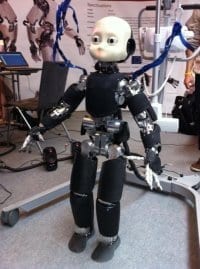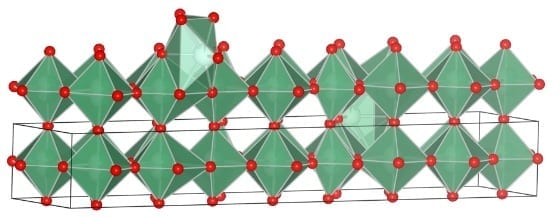
Most humanoid robots developed over the past few decades have had stiff joints, and that’s a problem if they’re ever going to interact with people.
Their unyielding arms and legs could injury a person if they accidentally whack someone, or if they lose balance and fall down. Lately there’s been a growing interest in developing robotic joints with variable stiffness, which would improve their safety, but so far few groups have built a complete robot. Now a team from the Italian Institute of Technology (IIT) is approaching that goal with their robot COMAN (COmpliant huMANoid).
Modeled on a four-year-old child, COMAN is 94.5 cm tall (from foot to neck) and weighs 31.2 kg. It features 25 degrees of freedom (DOF), and a combination of stiff and compliant joints (see diagram below). The compliant joints (14 DOF) rely on series elastic actuators. These actuators—a custom design created by the IIT team—are applied to the the flexion/extension of the arms and legs, and are both small and modular, which makes them ideal for multi-DOF robots like humanoids. The researchers have also built custom torque sensors for each of the elastic joints, including a 6-axis force/torque sensor for the ankle joints. Development of the robot is funded, in part, by the European AMARSI project.
So what exactly does this compliance get you? The elastic actuators literally add a spring to COMAN’s step: in walking experiments the robot’s hardware naturally absorbed the ground reaction forces of each footstep “without additional control enforcement, which is difficult to be realized by the stiff actuated humanoids if no particular foot mechanism or active control is applied.” And when they implemented a stabilization control method, the robot steadied itself on a moving platform and when it was knocked around.
COMAN’s internal structure is made of titanium alloy, stainless steel, and aluminum alloy, covered by an ABS plastic exoskeleton. The images below show the location and structure of the series elastic actuators (SEA) on the robot’s hips, knees, ankles, shoulders, and elbows.
In the course of developing their own compliant humanoid, the team also devised a method for determining the optimal joint elasticity, which until now has largely been a time-consuming trial and error process with scant documentation. Their method provides a framework for other researchers exploring compliant robots and is based on resonance analysis and energy storage maximization criteria.
The Latest Bing News on:
Humanoid Robot
- Tesla Is Staking Its Future On This Painfully Slow Roboton May 7, 2024 at 9:57 am
Last month, on a very odd investor call, Elon Musk declared that Tesla was no longer a car company. It’s a robotics company now, an AI company, and the cars are just means to that end. So how’s the whole robotics thing going? Well, according to a new video from the Optimus team, very slowly.
- Tesla releases new Optimus humanoid robot video that creates controversyon May 6, 2024 at 1:42 pm
Tesla has released a new video of a prototype of Optimus, its humanoid robot, and it created some controversy as some disagree about how impressive it is.
The Latest Google Headlines on:
Humanoid Robot
[google_news title=”” keyword=”Humanoid Robot” num_posts=”10″ blurb_length=”0″ show_thumb=”left”] [/vc_column_text]The Latest Bing News on:
Human-like robots
- Elon Musk's Tesla could soon have one billion 'humanoid robots' in circulationon May 8, 2024 at 8:17 am
Tesla CEO Elon Musk has said there is 'no real limit' to the value of the 'humanoid robots' his company is building, and has suggested that one billion of his cyborgs could soon be in circulation ...
- China's AI Advancements Accelerate Humanoid Robot Development: What You Need To Knowon May 8, 2024 at 2:30 am
China is witnessing a rapid advancement in the field of artificial intelligence, which is significantly accelerating the development of humanoid robots. What Happened: The emergence of AI models like ...
- Generative AI is speeding up human-like robot development. What that means for jobson May 7, 2024 at 6:56 pm
ChatGPT-like artificial intelligence is speeding up research and bringing humanoid robots closer to reality in China, home to many of the world's factories.
- As Amazon's robot ranks swell, workers worry about their futureon May 6, 2024 at 8:25 am
Amazon's use of robots in its fulfillment centers and warehouses goes back more than a decade, but it really started ramping up the numbers in recent ...
- From Robots to AI: Understanding the Uncanny Valley in Digital Innovationon May 2, 2024 at 6:03 am
As technology and AI continue to advance, pushing the boundaries of realism, it becomes crucial to understand where this phenomenon can have a negative impact.
- Humanoid Robot With AI Mind Is Meant to Think Just Like People, And It’s Learningon May 2, 2024 at 1:10 am
Canadian startup Sanctuary AI introduces the seventh generation of the Phoenix robot with a mind and capabilities meant to mimic the human one ...
- WATCH: Chery reveals new human-like AI roboton May 1, 2024 at 9:40 pm
Despite the number of films that have presented the potential dangers of creating humanoid robots, it seems the human race is full steam ahead in developing these AI-powered machines.
- A|I: The AI Times – Meet Sanctuary AI’s most human-like robot yeton May 1, 2024 at 1:59 am
Sanctuary AI claims Phoenix can now automate new tasks in less than 24 hours. In addition to improving the functions of its robot, Sanctuary AI says it has also increased the speed at which the ...
- Startling vision of advanced new humanoid robot that can cook and cleanon April 30, 2024 at 7:07 am
The International Federation of Robotics said human-like designs with two arms and two legs allow robots to be used flexibly in work environments that were created for humans. “Robotics is a ...
- You can buy this flame-throwing robot dog for less than $10,000on April 27, 2024 at 12:10 pm
A flame-throwing robot dog is now available to purchase for under $10,000, and it's actually legal in 48 states.
The Latest Google Headlines on:
Human-like robots
[google_news title=”” keyword=”human-like robots” num_posts=”10″ blurb_length=”0″ show_thumb=”left”]










